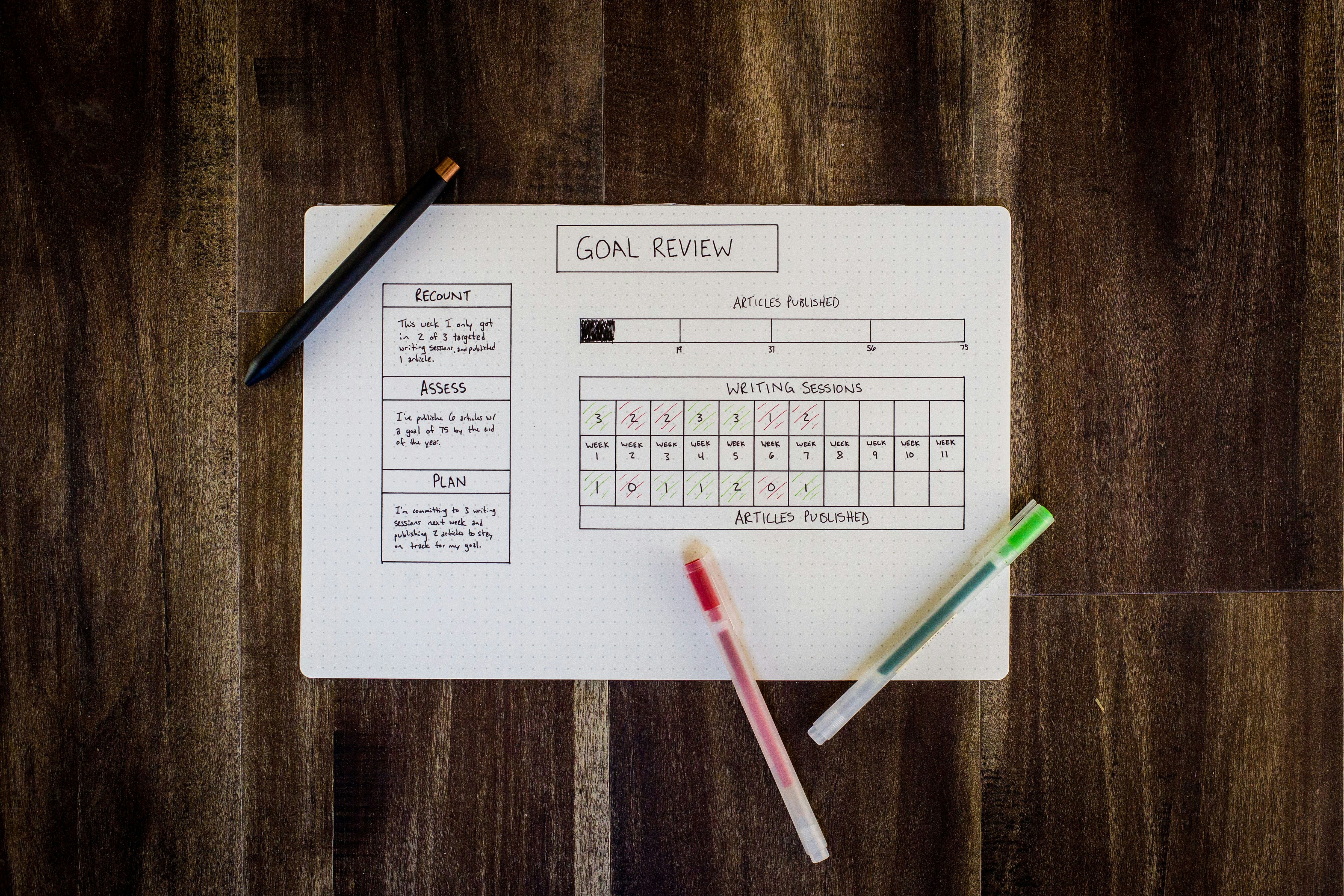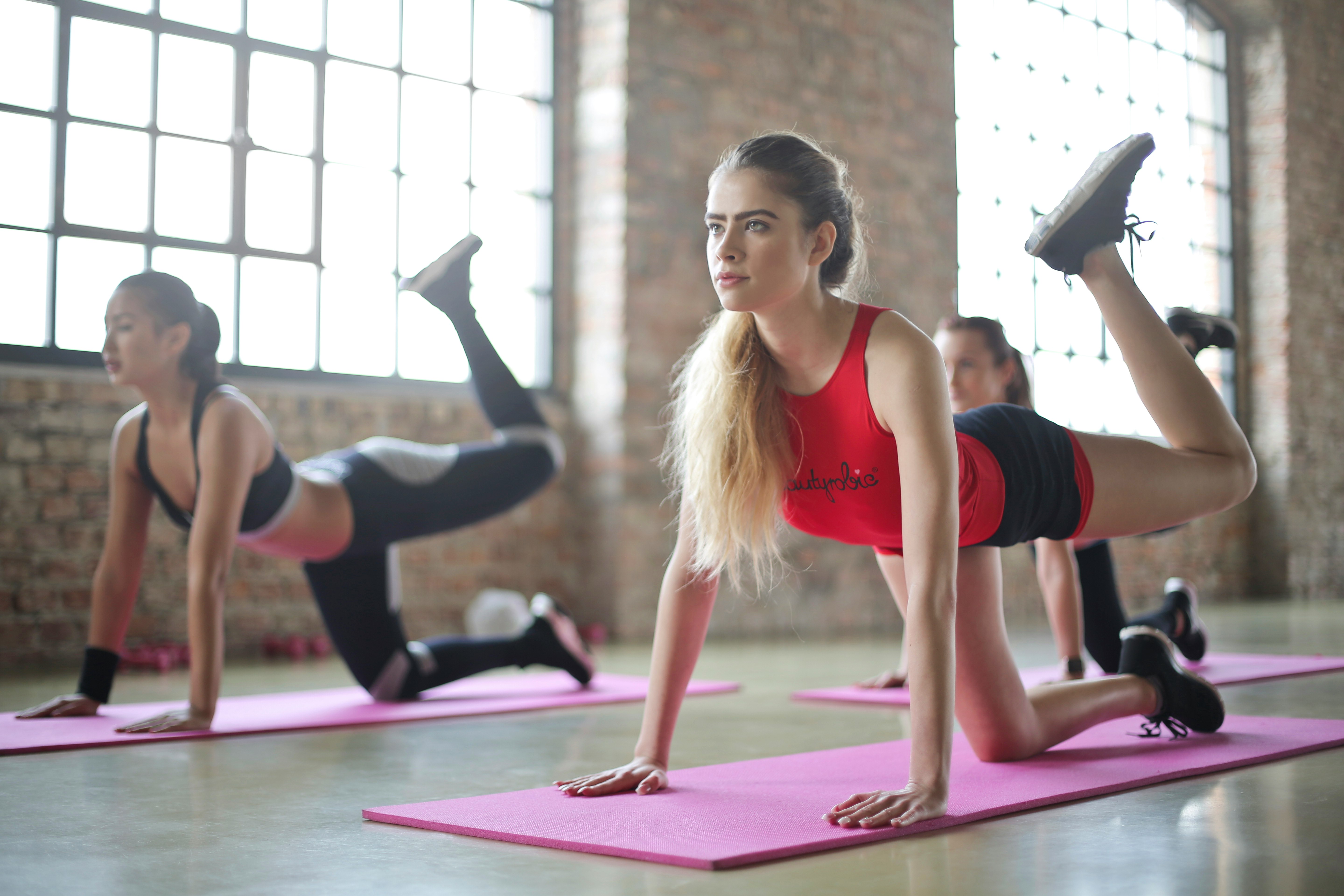Creating a consistent exercise routine is crucial for maintaining good physical and mental health. However, sticking to a regular workout plan can be challenging, especially if you're new to exercise or need more motivation. In this article, we'll explore tips for creating a sustainable exercise routine that you can stick to in the long run.
Here are some tips for creating a sustainable exercise routine.
1. Set clear goals
Before you start your exercise routine, it's important to have a clear idea of what you want to achieve. For example, do you want to lose weight, build muscle, or improve your fitness level? Knowing your goals will help you choose the right type of exercise and determine how often you need to work out.
Here are some additional, more detailed points to consider when setting clear goals for your exercise routine:
- Determine your goals for each aspect of fitness: There are several different aspects of fitness, including cardiovascular endurance, muscular strength and endurance, flexibility, and body composition. It's important to consider what you want to achieve in each of these areas and set specific goals accordingly.
- Break your goals into smaller, more manageable chunks: Instead of setting a goal to lose 50 pounds, for example, try breaking it down into smaller chunks, such as losing 5 pounds per month. It will make the goal more achievable and help you track your progress more quickly.
- Set short-term and long-term goals: It's helpful to work towards short-term and long-term goals. Short-term goals include increasing your endurance or strength, while long-term goals include losing a certain amount of weight or preparing for a specific event.
- Make sure your goals are realistic and achievable: While challenging yourself is essential, it's also important to set realistic and achievable goals. If you set goals that are easy to reach, you may become discouraged and give up. Consider your current fitness level, available time and resources, and any physical limitations when setting your goals.
- Consider your values and priorities: When setting your goals, it's essential to consider them. For example, if family time is a high priority, you may need to set goals to balance your exercise routine with your family commitments.
- Write your goals down and track your progress: Seeing your goals in writing can help make them feel more natural and give you something to refer back to when you need motivation. It's also helpful to track your progress to see how far you've come and stay motivated to continue.
2. Choose activities you enjoy
If you hate running, you will only stick to a running routine for a short time. Instead, choose activities you genuinely enjoy, swimming, dancing, or lifting weights. You'll be more motivated to stick with your exercise routine.
Here are some additional, more detailed points to consider when choosing activities you enjoy for your exercise routine:
- Explore various activities: There are countless types of exercise to choose from, so it's a good idea to try out different activities to see what you like best. It might include running, cycling, swimming, dancing, yoga, strength training, or team sports.
- Consider your interests and preferences: Think about what you enjoy doing in your free time and how you like to move your body. Do you prefer solo activities or group activities? Do you enjoy high-intensity workouts or more relaxed, low-impact activities? Choosing activities that align with your interests and preferences will make you more likely to stick with your exercise routine.
- Consider your fitness level: It's important to choose activities that are appropriate for your fitness level. If you're new to exercise or have physical limitations, start with low-impact activities or work with a personal trainer to develop a safe and effective routine.
- Experiment and have fun: Be bold, try new activities, and mix things up. You might find that you enjoy something you never thought you would or that a particular activity is more fun when done with a group or in a different setting. The important thing is to have fun and find activities that you genuinely enjoy.
- Seek support and guidance: If you're having trouble finding activities you enjoy, consider seeking support and guidance from a personal trainer, coach, or fitness instructor. They can help you explore different options and find activities that are enjoyable and effective for you.
3. Find a workout buddy
Working out with a friend or family member can help keep you accountable and motivated. Having a workout buddy can also make exercise more enjoyable and make time fly faster.
Here are some additional, more detailed points to consider when finding a workout buddy:
- Choose a compatible workout buddy: It's essential to choose a workout buddy consistent with your fitness goals, schedule, and personality. Look for someone who shares similar interests, has an equivalent fitness level, and is available to work out at the exact times as you.
- Set clear expectations and boundaries: Before you start working out with a buddy, it's a good idea to set clear expectations and boundaries. It might include how often you'll work out together, what activities you'll do, and how you'll communicate and support each other.
- Find ways to make your workouts fun and enjoyable: Working out with a buddy can make exercise more enjoyable, but finding ways to keep things interesting is crucial. Consider trying out new activities or setting fun challenges for each other to keep things fresh and exciting.
- Be supportive and encouraging: A good workout buddy should be supportive and encouraging rather than critical or judgmental. If you're having a tough time, your buddy should be there to offer encouragement and help you get back on track.
- Communicate openly and honestly: It's essential to communicate openly and honestly with your workout buddy. If you're having trouble sticking to your routine or need adjustments, be upfront about it. Your buddy should be understanding and willing to work with you to find solutions.
- Have a backup plan: It's always a good idea to have a backup plan in case your workout buddy can't make it to a session. Consider having a list of alternative activities you can do on your own or with another workout buddy. This will help you stay on track even if your regular workout buddy is unavailable.
4. Set a regular schedule
Consistency is key when it comes to maintaining a sustainable exercise routine. Choose a time of day that works best for you and stick to the same schedule as much as possible. It will help you develop a habit of exercising regularly.
Here are some additional, more detailed points to consider when setting a regular schedule for your exercise routine:
- Consider your daily routine and commitments: When setting a regular schedule, it's essential to consider your daily routine and obligations. Choose a time of day that works best for you and that you're most likely to stick to. It might be first thing in the morning, during your lunch break, or after work.
- Make exercise a priority: Exercise should be a priority in your life, so it's important to schedule it like any other important commitment. Set aside specific times for exercise and treat them as non-negotiable appointments.
- Plan for flexibility: While consistency is important, it's also important to be flexible and allow some wiggle room in your schedule. Sometimes, life can get in the way, so it's okay to adjust your plan as needed. Make sure to prioritize exercise and stick to your regular schedule as much as possible.
- Use tools to help you stay on track: Many tools and resources are available to help you stay on track with your exercise routine. Consider using a planner or scheduling app to help you manage your time and schedule workouts in advance. Setting reminders or alerts to help you remember to exercise is also helpful.
- Be consistent but also allow for rest: It's essential to be compatible with your exercise routine, but it's also important to allow rest and recovery. Make sure to schedule rest days into your practice and listen to your body when it needs a break.
5. Mix things up
While consistency is important, mixing things up to avoid boredom and prevent plateaus is also essential. Try incorporating different types of exercise into your routines, such as cardio, strength training, and flexibility work. You can also try new workouts or switch up your routine to keep things interesting.
Here are some additional, more detailed points to consider when mixing things up in your exercise routine:
- Incorporate different types of exercise: It's essential to include various activities to challenge your body and avoid boredom. This might include cardiovascular exercise, strength training, flexibility work, and balance and coordination exercises. By incorporating different types of practice, you can work for other muscle groups and improve your overall fitness level.
- Vary the intensity of your workouts: Mixing up the power of your activities can help prevent boredom and keep your body guessing. Consider incorporating high-intensity interval training (HIIT) or other high-intensity workouts into your routine and low-intensity activities like yoga or walking.
- Try new workouts and activities: Experimenting with new exercises and activities can keep things interesting and help you avoid boredom. It might include trying a new class at the gym, joining a sports team, or trying a recent outdoor activity like hiking or kayaking.
- Change up your routine: Mixing things up doesn't have to mean trying completely new activities. You can also switch up your routine by doing different exercises within the same activity, changing the order of your workouts, or trying a new route or location.
- Set new goals and challenges: Setting new goals and challenges can help keep things interesting and prevent plateaus. It might include increasing the weight you lift, running a faster mile, or completing a certain number of reps in a given time frame.
- Get creative: There are countless ways to mix things up in your exercise routine. Be creative and think outside the box. You might enjoy working in a new setting, like the park or beach, or you want to try recent fitness trends or challenges.
6. Listen to your body
Exercise is vital for maintaining good health, but it's also important to listen to your body and not push yourself too hard. If you're feeling tired or sore, take a rest day or reduce the intensity of your workout.
Here are some additional, more detailed points to consider when listening to your body during your exercise routine:
- Pay attention to your energy levels: It's essential to listen to your body and pay attention to your energy levels when exercising. If you're tired, take a break or reduce the intensity of your workout.
- Respect your limits: Everyone has different physical abilities and limits, and it's crucial to respect yours. Don't try to push yourself too hard or do more than your body is capable of. It can lead to injury and burnout, making it harder to stick to your exercise routine.
- Pay attention to your body's warning signs: Your body will often give you warning signs when something isn't right. Pay attention to these signs and take action if necessary. For example, stop and assess the situation if you experience pain or discomfort while exercising. If the pain persists or is severe, it's a good idea to speak with a healthcare professional.
- Take rest days: It's important to include rest days in your exercise routine to allow your body to recover and repair. If you're feeling particularly sore or tired, it's okay to take an extra rest day or reduce the intensity of your workout.
- Don't compare yourself to others: It's easy to get caught up in comparing yourself to others, especially regarding exercise. But it's important to remember that everyone is different and has different physical abilities and limitations. Don't push yourself too hard trying to keep up with others. Instead, focus on your progress and listen to your body.
7. Get enough rest
Getting enough sleep is crucial for maintaining energy levels and supporting recovery from exercise. Aim for 7-9 hours of sleep per night to help you feel rested and ready to tackle your workouts.
Here are some additional, more detailed points to consider when getting enough rest to support your exercise routine:
- Make sleep a priority: Sleep is an essential component of overall health and well-being and is especially important for supporting recovery from exercise. Make sleep a priority by setting aside enough time and creating a conducive sleep environment.
- Establish a consistent sleep routine: A consistent sleep routine can help you fall asleep faster and sleep more soundly. Consider going to bed and waking up at the same time every day, and try to limit your exposure to screens and other sources of blue light in the hours leading up to bedtime.
- Create a comfortable sleep environment: A comfortable sleep environment can make a big difference in the quality of your sleep. Make sure your bedroom is calm, dark, and quiet, and invest in a comfortable mattress and pillows.
- Avoid caffeine and alcohol before bed: Caffeine and alcohol can disrupt sleep, so it's a good idea to avoid them before bedtime. If you consume these substances, be mindful of how they might affect your sleep.
- Try relaxation techniques: If you have trouble falling asleep or staying asleep, try using relaxation techniques such as deep breathing, progressive muscle relaxation, or meditation. These techniques can help calm your mind and body and prepare you for sleep.
8. Stay hydrated
Proper hydration is essential for maintaining energy and supporting physical performance during exercise. Make sure to drink plenty of water throughout the day, especially before and after your workouts.
Here are some additional, more detailed points to consider when staying hydrated to support your exercise routine:
- Understand your hydration needs: Your hydration needs will depend on a variety of factors, including your age, weight, physical activity level, and the climate you live in. Speaking with a healthcare professional or sports nutritionist is a good idea to determine your specific hydration needs.
- Drink water throughout the day: It's essential to drink water throughout the day, not just during or after your workouts. Carry a water bottle with you, and aim to drink at least 8 cups (64 ounces) of water daily.
- Drink before, during, and after exercise: Proper hydration is critical back, during, and after exercise. Aim to drink about 17 ounces (2 cups) of water 2-3 hours before exercise and about 7-10 ounces (1-1.25 cups) every 10-20 minutes during exercise. After your workout, drink enough water to rehydrate and entirely replace any fluids lost during exercise.
- Pay attention to thirst: Thirst is a good indicator of your hydration status. If you're feeling thirsty, it's a good idea to drink some water.
- Consider electrolyte replacement: If you're exercising for more extended periods or in hot or humid conditions, you may need to replace electrolytes in addition to water. Electrolytes, such as sodium, potassium, and magnesium, are essential for maintaining proper fluid balance. You can replace electrolytes by drinking sports drinks or eating foods high in electrolytes.
9. Fuel your body
Exercise requires energy, so fueling your body with the proper nutrients is essential. Choose a balanced diet that includes a variety of whole foods, such as fruits, vegetables, lean proteins, and healthy fats. Pre- and post-workout snacks can also help support recovery and maintain energy levels.
- Determine your caloric needs: To fuel your body for exercise, it's essential to ensure you're consuming enough calories to support your workouts. Your caloric needs will depend on your age, weight, physical activity level, and the intensity and duration of your workouts. A healthcare professional or sports nutritionist can help you determine your specific caloric needs.
- Choose a balanced diet: A balanced diet is essential for providing the nutrients your body needs to perform at its best. Choose a variety of whole foods, such as fruits, vegetables, lean proteins, and healthy fats. Avoid processed and sugary foods, which can provide empty calories and interfere with optimal performance.
- Incorporate carbohydrates: Carbohydrates are an essential source of energy for exercise. Choose complex carbohydrates, such as whole grains, legumes, and starchy vegetables, which provide sustained energy and are rich in fiber.
- Include protein in your diet: Protein is essential for repairing and rebuilding muscle tissue and can help support recovery after exercise. Choose lean protein sources, such as chicken, fish, tofu, and legumes, and aim to consume about 0.36-0.45 grams of protein per pound of body weight.
- Remember about healthy fats: Healthy fats, such as those found in nuts, seeds, and avocados, can provide energy and support overall health. Aim to consume about 20-30% of your daily calories from healthy fats.
- Consider pre-, and post-workout snacks: Pre- and post-workout snacks can help support recovery and maintain energy levels. Pre-workout snacks should provide easily digestible carbohydrates and a small amount of protein to fuel your body. Post-workout snacks should contain a balance of carbohydrates and protein to help repair and rebuild muscle tissue.
10. Find a supportive environment.
Surrounding yourself with supportive friends and family members can make it easier to stick to your exercise routine. Look for a gym or fitness community that makes you feel welcome and motivated to work out.
- Surround yourself with supportive people: Having supportive friends and family can make it easier to stick to your exercise routine. Look for people who will encourage and motivate you rather than those who might discourage or judge you.
- Find a gym or fitness community that makes you feel welcome: The gym or fitness community you choose can significantly impact your experience. Look for a gym or community that makes you feel welcome and comfortable rather than one that makes you feel self-conscious or unwelcome.
- Consider hiring a personal trainer or coach: A personal trainer or coach can provide motivation, guidance, and accountability to help you stick to your exercise routine. They can also help you develop a customized workout plan that meets your specific goals and needs.
- Find a workout buddy: Working with a friend or family can help keep you accountable and motivated. Having a workout buddy can also make exercise more enjoyable and make time fly faster.
- Use technology to your advantage: Many apps and online resources can help you track your workouts and progress, connect with others for motivation and support, and find new workout ideas. Consider using these resources to help keep you motivated and on track.
- Take breaks when needed: It's essential to listen to your body and not push yourself too hard. Taking a break and resting is okay if you're tired or burnt out. Be bold and take a day or two off if you need to. Taking breaks can help prevent burnout and make it easier to stick to your exercise routine in the long run.
By following these tips, you can create a sustainable exercise routine that supports your physical and mental health and helps you achieve your fitness goals. Remember to be patient and consistent, and don't get discouraged if you have setbacks. Dedication and determination can create a healthy, sustainable exercise routine that works for you.
By setting clear goals, choosing activities you enjoy, finding a workout buddy, setting a regular schedule, mixing things up, listening to your body, getting enough rest, staying hydrated, fueling your body, and finding a supportive environment, you can create a sustainable exercise routine that supports your physical and mental health and helps you achieve your fitness goals. Remember to be patient and consistent, and don't get discouraged if you have setbacks. Dedication and determination can create a healthy, sustainable exercise routine that works for you.














